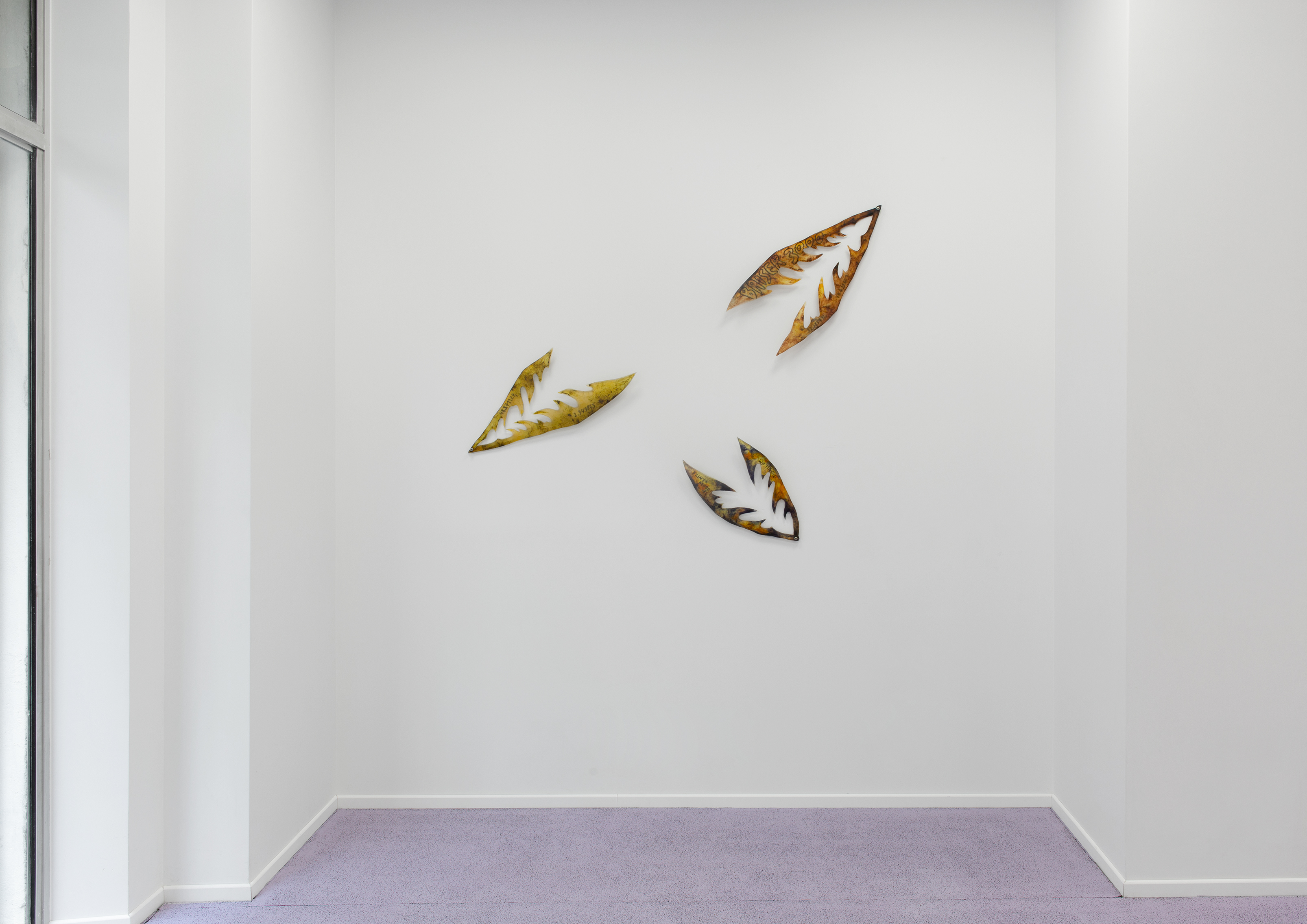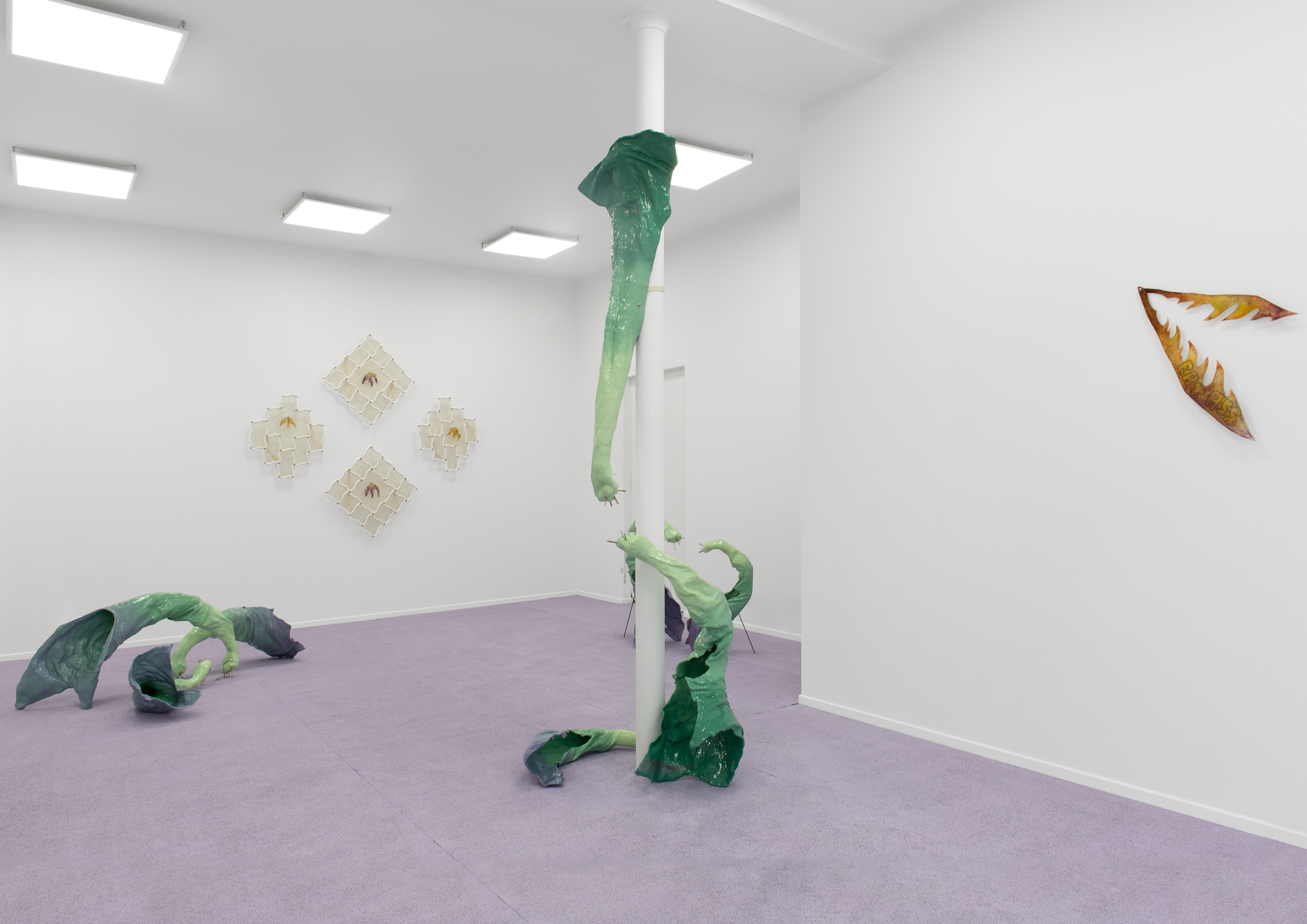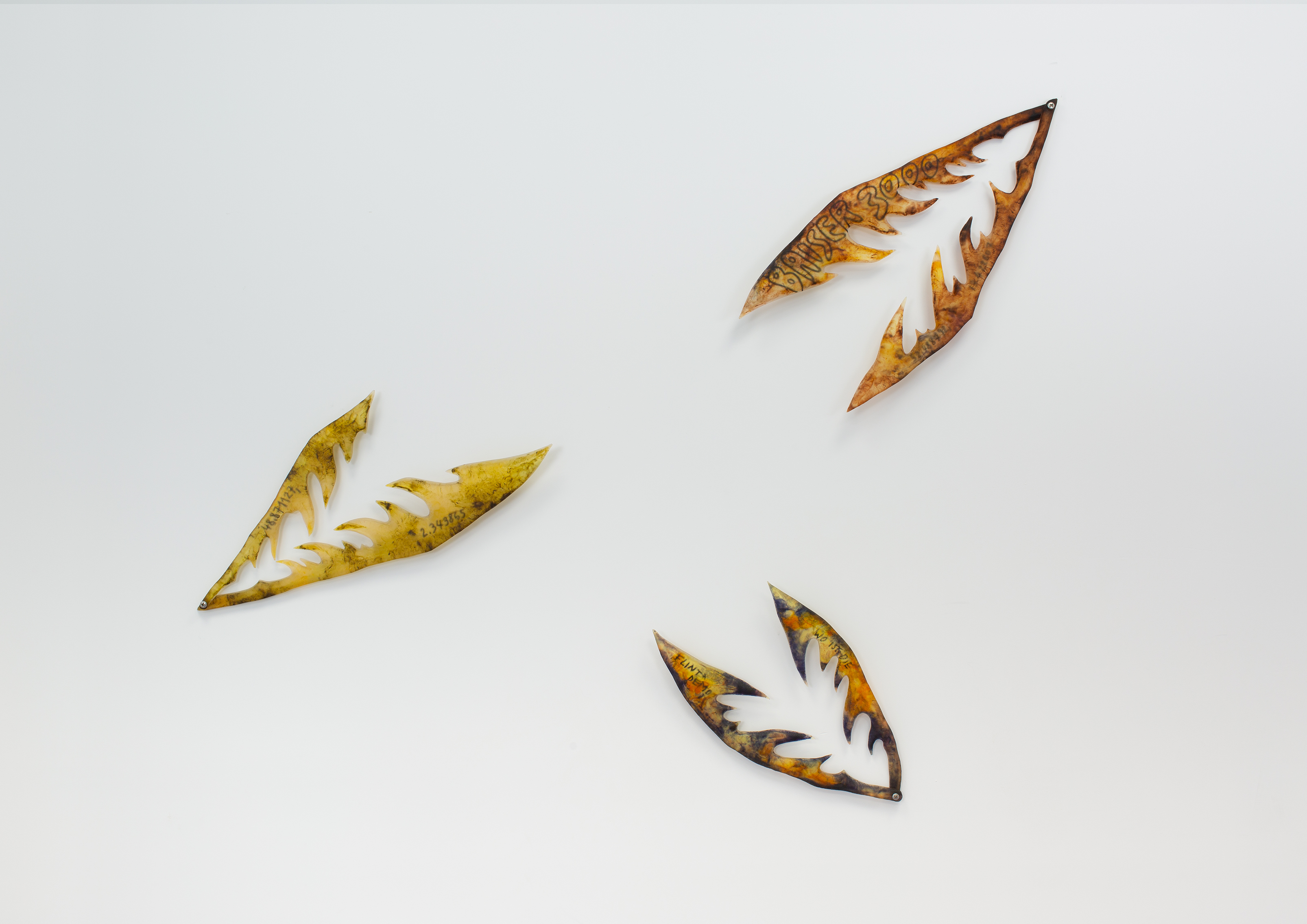dandelion menace
Solo Exhibition at Artemis Fontana, Paris
Curated by Thomas Conchou
05.06.2021 – 26.06.2021

dandelion menace
Exhibition view
Exhibition view


Pissed (FLINTA dandelion), 2021
Pigmented resin, pen, steel, 50 x 22 cm
Pigmented resin, pen, steel, 50 x 22 cm


Up: Soft and Stone and High (M), 2020
Fabric, resin, plaster, paint, varnish, metal, 143 x 48 x 30 cm
Down: Soft and Stone and High (ER), 2020
Fabric, resin, plaster, paint, varnish, metal, 98 x 57 x 50 cm
Fabric, resin, plaster, paint, varnish, metal, 143 x 48 x 30 cm
Down: Soft and Stone and High (ER), 2020
Fabric, resin, plaster, paint, varnish, metal, 98 x 57 x 50 cm



Pissed (Butler’s dandelion), 2021
Pigmented resin, pen, steel, 63 x 20 cm
Pigmented resin, pen, steel, 63 x 20 cm

Left: Soft and Stone and High (MJ), 2020
Fabric, resin, plaster, paint, varnish, metal, 84 x 36 x 35 cm
Middle: Soft and Stone and High (LA), 2020
Fabric, resin, plaster, paint, varnish, metal, 107 x 57 x 35 cm
Right: Soft and Stone and High (ND), 2020
Fabric, resin, plaster, paint, varnish, metal, 40 x 80 x 44 cm
Fabric, resin, plaster, paint, varnish, metal, 84 x 36 x 35 cm
Middle: Soft and Stone and High (LA), 2020
Fabric, resin, plaster, paint, varnish, metal, 107 x 57 x 35 cm
Right: Soft and Stone and High (ND), 2020
Fabric, resin, plaster, paint, varnish, metal, 40 x 80 x 44 cm


under no king (1 & 2), 2021
Resin, painted wood, varnish, dead lily, strap, steel, 76 x 76 x 6 cm
under no king (3 & 4), 2021
Resin, painted wood, varnish, dead lily, strap, steel, 56 x 66 x 6 cm
Resin, painted wood, varnish, dead lily, strap, steel, 76 x 76 x 6 cm
under no king (3 & 4), 2021
Resin, painted wood, varnish, dead lily, strap, steel, 56 x 66 x 6 cm

Right: Soft and Stone and High (AM), 2020
Fabric, resin, plaster, paint, varnish, metal, 90 x 60 x 43 cm
Left: Soft and Stone and High (AL), 2020
Fabric, resin, plaster, paint, varnish, metal, 73 x 50 x 28 cm
Fabric, resin, plaster, paint, varnish, metal, 90 x 60 x 43 cm
Left: Soft and Stone and High (AL), 2020
Fabric, resin, plaster, paint, varnish, metal, 73 x 50 x 28 cm


Left: Pissed (Pulp dandelion), 2021
Pigmented resin, pen, steel, 67 x 33 cm
Right: Pissed (Baiser 3000 dandelion), 2021
Pigmented resin, pen, steel, 65 x 25 cm
Bottom: Pissed (FLINTA dandelion), 2021
Pigmented resin, pen, steel, 50 x 22 cm
Pigmented resin, pen, steel, 67 x 33 cm
Right: Pissed (Baiser 3000 dandelion), 2021
Pigmented resin, pen, steel, 65 x 25 cm
Bottom: Pissed (FLINTA dandelion), 2021
Pigmented resin, pen, steel, 50 x 22 cm

Pissed (Eat Ass dandelion), 2021
Pigmented resin, pen, steel, 66 x 40 cm
Pigmented resin, pen, steel, 66 x 40 cm

dandelion menace
Publication
Publication

dandelion menace
Exhibition view
Exhibition view
dandelion menace
curated by Thomas Conchou
dandelion menace is Claude Eigan's first monographic exhibition in France. It unfolds around plant presences that form three families: fists bouquets, shields corollas, and wolf trap leaves, all linked to the central figure of taraxacum, which gives the exhibition its title. Commonly called pissenlit in French (piss in bed), in reference to its diuretic properties, this plant with depurative virtues is also called dent-de-lion for its sharp leaves and bushy yellow collar. The works presented at Artemis Fontana all trace, in their own way, the emotional coordinates of the artist. The fists of their friends and relatives make up the intertwined cornucopias in the series Soft and Stone and High, 2020, chimerical presences oscillating between the floral and the aquatic: somewhat plants, somewhat mermaids. The outlines of Berlin's pavements inhabit the series under no kings, 2021, composed of wall pieces arranged in a defensive formation. Straps in the back allow them to be worn on the arm while brandishing white and purple fleur-de-lis, placed upside down in a cheeky misuse of royal and religious emblems. Finally, the coordinates of LGBTQIA+ places dear to the artist adorn the laughing jaws of the dandelion’s leaves in the series Pissed, 2021, alongside queer slogans and symbols.
Here, the flowers have left their lustful attitudes and have become sharp, ready to sting, defend and attack. Just as Hammurabi's code enshrined the saying "an eye for an eye, a tooth for a tooth" in Babylon, Claude Eigan's works appropriate the Pink Panthers Patrol's famous "Bash Back!": they reclaim rage as a political space, and explore the continuum of threat, violence, and retribution from a minoritarian position. These flowers of resilience give shape to a garden of self-defense, where the dialectic between the representation of violence and violent action unfolds like the two sides of a labrys, the double-bladed axe used by the Minoan civilization as a religious symbol; historically associated with the Amazons, it was adopted in the 70s by lesbian feminist movements and placed on their flags.
curated by Thomas Conchou
dandelion menace is Claude Eigan's first monographic exhibition in France. It unfolds around plant presences that form three families: fists bouquets, shields corollas, and wolf trap leaves, all linked to the central figure of taraxacum, which gives the exhibition its title. Commonly called pissenlit in French (piss in bed), in reference to its diuretic properties, this plant with depurative virtues is also called dent-de-lion for its sharp leaves and bushy yellow collar. The works presented at Artemis Fontana all trace, in their own way, the emotional coordinates of the artist. The fists of their friends and relatives make up the intertwined cornucopias in the series Soft and Stone and High, 2020, chimerical presences oscillating between the floral and the aquatic: somewhat plants, somewhat mermaids. The outlines of Berlin's pavements inhabit the series under no kings, 2021, composed of wall pieces arranged in a defensive formation. Straps in the back allow them to be worn on the arm while brandishing white and purple fleur-de-lis, placed upside down in a cheeky misuse of royal and religious emblems. Finally, the coordinates of LGBTQIA+ places dear to the artist adorn the laughing jaws of the dandelion’s leaves in the series Pissed, 2021, alongside queer slogans and symbols.
Here, the flowers have left their lustful attitudes and have become sharp, ready to sting, defend and attack. Just as Hammurabi's code enshrined the saying "an eye for an eye, a tooth for a tooth" in Babylon, Claude Eigan's works appropriate the Pink Panthers Patrol's famous "Bash Back!": they reclaim rage as a political space, and explore the continuum of threat, violence, and retribution from a minoritarian position. These flowers of resilience give shape to a garden of self-defense, where the dialectic between the representation of violence and violent action unfolds like the two sides of a labrys, the double-bladed axe used by the Minoan civilization as a religious symbol; historically associated with the Amazons, it was adopted in the 70s by lesbian feminist movements and placed on their flags.
The hovering violence surrounding dandelion menace works as a
symbolic threat, residing more in the anticipation of its implementation rather
than in its action. Rather, we are left with a disarmed threat, and the
imminence of a different future. Of the solar, royal, and masculine symbol of
the lion, assumed to bring honor to its vegetal look-alike, Claude retains
nothing. Instead, they choose to put forward the vivacious and urban
characteristics of the dandelion: capable of growing between the cracks of
concrete, the cobblestones of the streets, and through the tar. Placing itself
in a post-humanist perspective, the exhibition argues for the definition of
complex, inclusive, and shifting political subjects that account for the vulnerability
of bodies, and calls for a future where rage, violence, and anger have become
historical cultural practices, whose necessity has faded.
Text by Thomas Conchou, 2021
All pictures copyright Margot Montigny
Text by Thomas Conchou, 2021
All pictures copyright Margot Montigny